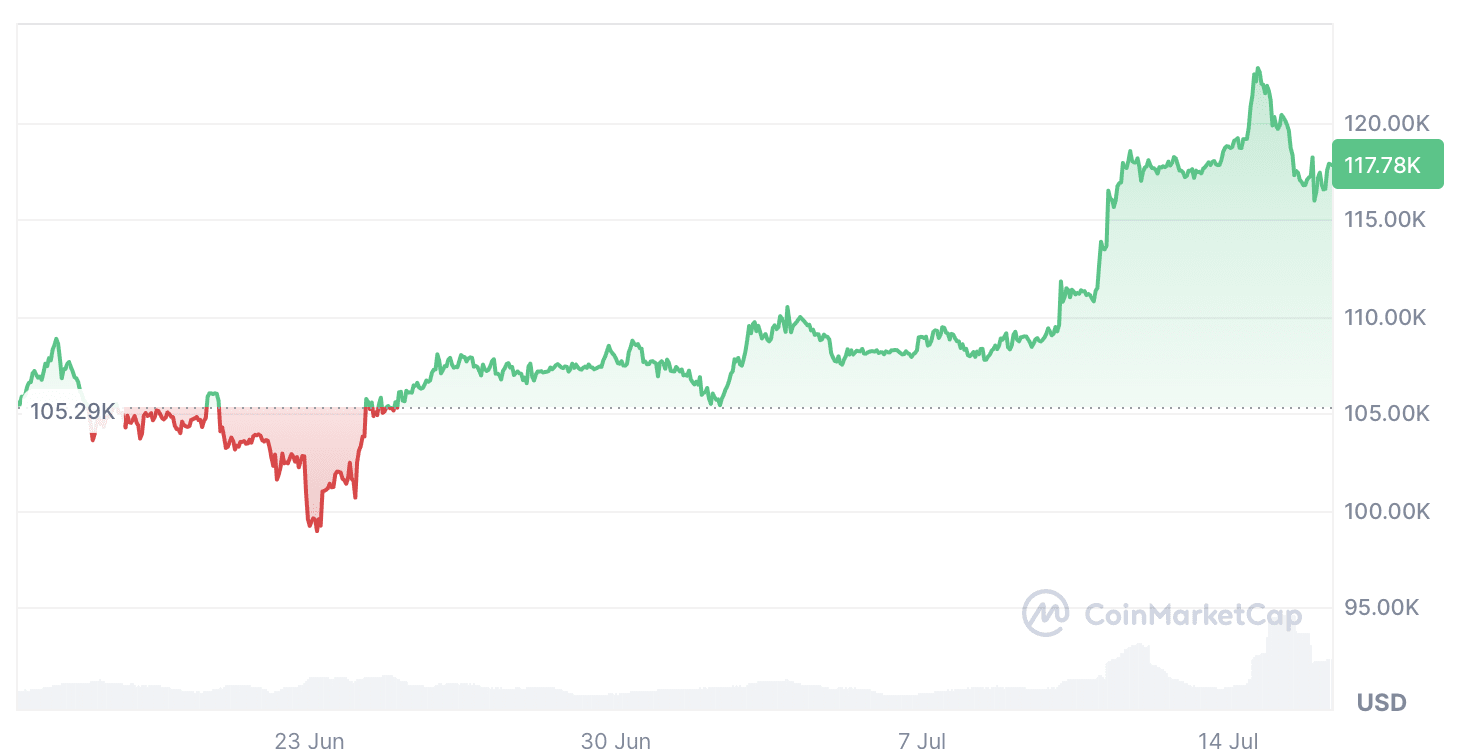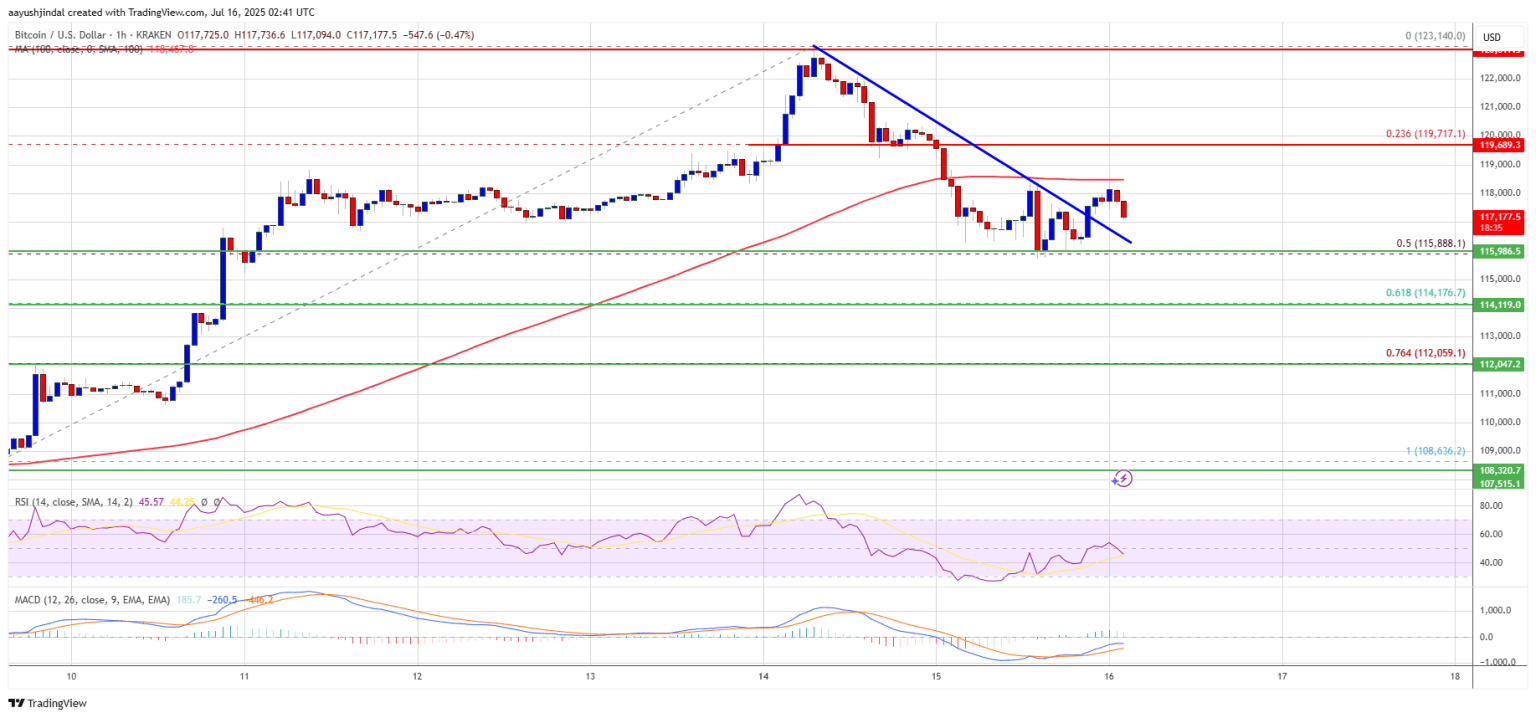After breaking through the $120,000 mark and setting a new all-time high, Bitcoin faced a wave of profit-taking, subsequently falling below $120,000. On Wednesday (July 16), Bitcoin maintained a slight upward trend above $117,000, following a failure of previous breakout attempts, showing high volume support, narrowing ranges, and weakened liquidity, indicating market fatigue and waiting for the next round of macro catalysts.

Ethereum surged 2.6% to $3,066.57 in a volatile 24 hours, rebounding from a low of $2,933.50, breaking through $3,075 due to institutional capital inflow, record staking volume, and strong trading volume, showing new bullish momentum.
While some market participants still believe the rally has just begun, even calling for BTC to hit targets of $160,000, $200,000, or even higher, OKX Chief Business Officer Lennex Lai warned that risks are accumulating at the same pace as market enthusiasm.
Lai said in an interview with CoinDesk via Telegram: 'Across platforms, we see aggressive long positions increasing, funding rates expanding, and news related to 'crypto week' boosting sentiment. But at these levels, risks could accumulate quickly—escalating tensions with trade partners like the EU and Mexico could trigger sharp corrections. Another risk is letting exuberant sentiment dominate decision-making.'
He noted that the upcoming series of macro data—such as the UK CPI, US core PPI, retail sales, and consumer confidence—could affect global risk sentiment and set the tone for the broader market.
These concerns echo the findings of K33 Research in its market report for the first half of 2025, which had previously highlighted similar risks and volatility triggers. K33 pointed out that geopolitical turmoil and trade policy uncertainty led to a 30% pullback to $75,000 at the beginning of the year.
The report specifically mentioned: 'During risk-off periods, Bitcoin struggles, but shows slight relative strength compared to the stock market, outperforming stocks after Liberation Day.'
Furthermore, K33 pointed out that while prices are rising, funding rates are at historical lows, indicating cautious sentiment among seasoned traders who remain wary of sudden reversals.
The report stated: 'The annualized funding rate averaged 4.51% in the first half of the year, the lowest semi-annual average since December 31, 2022, when we were in the winter following the FTX event.'
Lai added: 'At times like this, smart traders focus more on strategy rather than emotions, controlling risks with discipline. The excitement at high levels is real, but only those who seriously manage their entries, exits, and capital risk exposure can cope with whatever happens next.'
He summarized: 'Strong momentum does not mean the market is flawless.'
The possibility of a long-term Bitcoin pullback is getting lower.
Matt Mena, a crypto research strategist at crypto product provider 21Shares, stated in an interview with Cointelegraph: 'The structural imbalance between surging demand and rapidly disappearing supply makes the likelihood of a long-term pullback increasingly low.'
He added: 'Currently, the positives far outweigh the negatives.'
Mena indicated that the supply of Bitcoin on crypto exchanges and over-the-counter (OTC) platforms remains at historical lows, while demand for the cryptocurrency continues to rise. 'On the supply side, the fundamentals are severely imbalanced.'
Bitfinex noted that new buyers entering the Bitcoin market seem to be insensitive to price, purchasing at a faster rate than miners produce.
André Dragosch, head of research at Bitwise, pointed out last Friday that the Google search popularity of the term 'Bitcoin' has not significantly increased, which may indicate low interest from retail investors. Dragosch said: 'Bitcoin has reached an all-time high, but retail investors are almost nowhere to be seen.'
However, Mena also reminded that the possibility of a market reversal cannot be completely ruled out. 'Bitcoin may consolidate or even pull back, which is certainly possible.' He pointed out two potential macro risks that could weigh on the crypto market: if the tariffs proposed by Trump end up being more severe than the market currently expects; and if Powell hints that interest rate cuts are later than the market anticipates.
Mena stated that 21Shares does not expect a significant long-term pullback within the next six months.
Mena also said: 'Once summer ends and liquidity returns, we expect upward momentum to resume.' He added: 'What is truly noteworthy is that Bitcoin is still reaching new highs during the time of year with the worst liquidity and weakest seasonality.'
According to CoinGlass data, the third quarter has historically been the worst-performing quarter for Bitcoin since 2013, with an average return of only 6.32%.
Mena stated: 'Historically, summer markets tend to stagnate—traders are on vacation, volume decreases, and price movements are flat. However, this cycle is breaking that pattern.'
Bitcoin Technical Analysis
After breaking through the $118,500 resistance area, Bitcoin's price began a new round of increases. BTC accelerated past the $120,000 and $122,000 resistances. Bulls even pushed the price above $123,100, reaching a new historical high of $123,140 before starting to pull back. The BTC price dropped below the 23.6% Fibonacci retracement level of the rally from the low of $108,636 to the high of $123,140.
Bitcoin is currently trading below $120,500 and the 100-hour moving average. However, the price is holding above the 50% Fibonacci retracement level of the rally from $108,636 to $123,140.

Additionally, the BTC/USD hourly chart broke a bearish trendline resistance at $117,300. Immediate upward resistance is around $118,500, with the first key resistance at the $120,000 level, and the next resistance possibly at $122,000.
If a close above the $122,000 resistance is achieved, the price may rise further. In that case, the price could test the $123,200 resistance. Further increases could push the price towards the $125,000 level, with the primary target possibly at $130,000.
If Bitcoin fails to break through the $120,000 resistance area, it may continue to decline. Immediate support is around $115,850, with the first major support at the $115,500 level.
The next support is around $114,150. Further declines could push the price toward the $112,500 support area. The main support level is at $110,500; if it falls below this level, Bitcoin could further decline.
Main support levels: $115,500, followed by $114,150.
Main resistance levels: $120,000 and $122,000.


